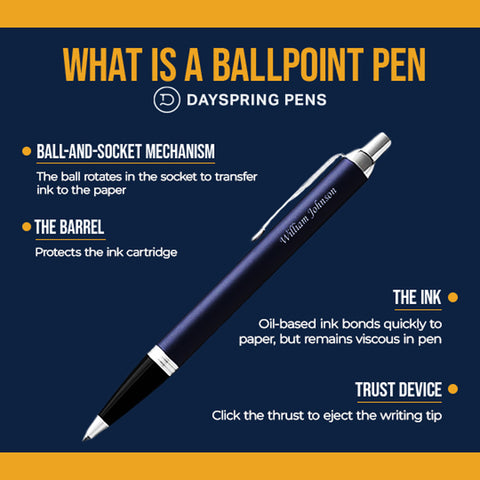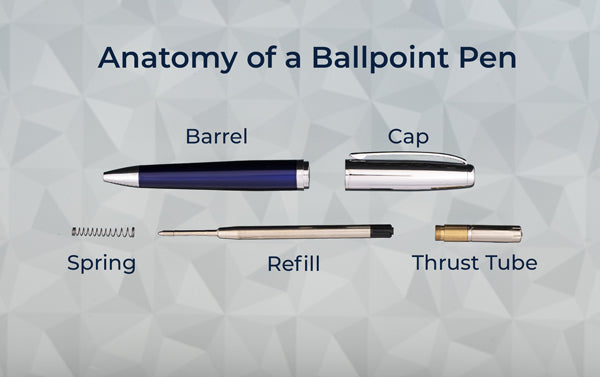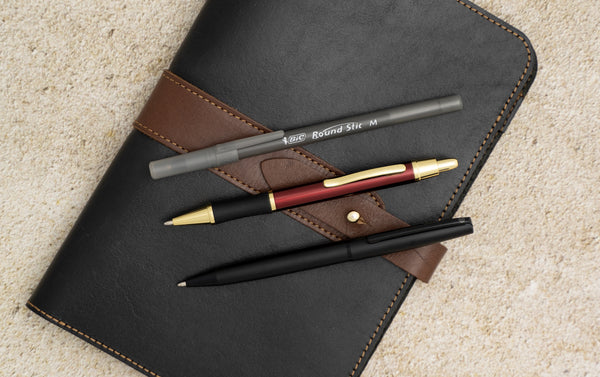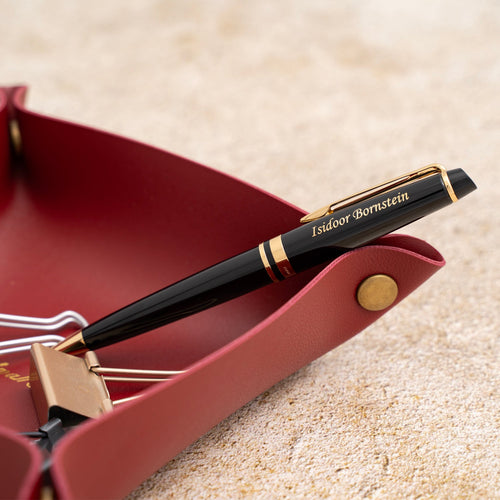What is a Ballpoint Pen?

What is a Ballpoint Pen?
Ballpoints. You have seen them, you have used them, you may have even chewed on the back of one till you got ink all over your face.
But what exactly is this household item and how does it work?
I am going to tell you all about the ballpoint pen, including:
- The origin and evolution of ballpoint pens
- How ballpoint pens are made
- The working mechanism of ballpoint pens
- Popular brands of ballpoint pens
Here’s everything you need to know about the pen that you’ll find in every office, classroom, and home.
Definition and Basic Components
As the name suggests, ballpoint pens use a small ball at the end of an ink cartridge to transfer ink from the cartridge to a writing surface.
Ballpoint pens consist of the following parts:
- Rotating ball-and-socket mechanism
- Ink cartridge/reservoir
- Body
- Cap
Click-action ballpoint pens also have:
- Thrust device/cam body
- Spring
The Mechanism
The rotating ball is usually made of steel, brass, or most often tungsten carbide. Brass, which is a zinc-copper alloy, is used to make the point that holds the ball. The corrosion resistance, strength, aesthetic and easy workability of these metals make them ideal materials.
Fun Fact: The ball isn’t completely smooth. Instead, it has over 50,000 polished surfaces and tiny indents. A series of channels running all over the sphere connect these indents, allowing the ink to be present both on the surface and interior of the ball for a continuous flow of ink.
The Ink Cartridge
Made of plastic, steel, or aluminum, the ink cartridge contains the ball-and-socket as well as the reserve of ballpoint ink.
The cartridge is generally interchangeable.
The Body and Cap
Whether you have a capped ballpoint or a click-action pen, the body and cap will vary greatly by design, material, and weight. Basically, if you want it as a ballpoint pen chances are you can find it as a ballpoint pen.
How Do Ballpoint Pens Work?
Ballpoint pens use the same mechanism as a roller bearing or a roll-on tube. A ball rotates in a socket keeps the ball firmly in place, yet leaves enough room for it to move around when you write.
As the ball turns, gravity and friction pull an oil-based ink down the reservoir onto the paper. When the ball is not in motion, the edges seal against the socket, preventing the ink from being exposed to air and drying out.
It is the oil-based ink that is pivotal to the functionality of the ballpoint and makes it the most popular writing instrument.

In order for the ink to move around the ball without clogging or drying out, the ink must be viscous and oily.
This makes it slow to evaporate in the cartridge (which means ballpoint pens can last a long time unused), but quick drying to porous surfaces like paper (the oil binds to the fibers of the paper almost instantaneously.)
The composition of the ink: 25-40% dye or pigment mixture dispersed in a combination of fatty acids and oil ensures that the ink doesn’t sit on the surface of the paper for long before drying.
Fatty acids, softeners, polymeric resins, and other additional components are included to improve the flow, consistency, and drying properties of the ink. For example, fatty acids lubricate the ball for smooth movement during writing.
Manufacturers also include different additives to stabilize the mixture. As a result, the ink is thick enough to not leak out of the reservoir, while simultaneously being thin enough for gravity to pull it towards the tip.
Fun Fact: On average, a ballpoint pen can write 45,000 words before running dry.
The video below demonstrates how a ballpoint pen works:
How the Click-Action Works
How does the soothing sound and addictive snap of the click mechanism work? Let’s take a look.
When you press the button on the cap, the spring-loaded ink cartridge rotates, extends, and locks into place, pushing the ballpoint tip outside the pen body. Pushing the button again rotates the cartridge in the opposite direction, retracting the tip.
Twist-action pens use a similar mechanism activated by twisting the cap. Engineer Guy has a wonderful video that explains the workings of a retractable ballpoint pen in detail:
History of Ballpoint Pens
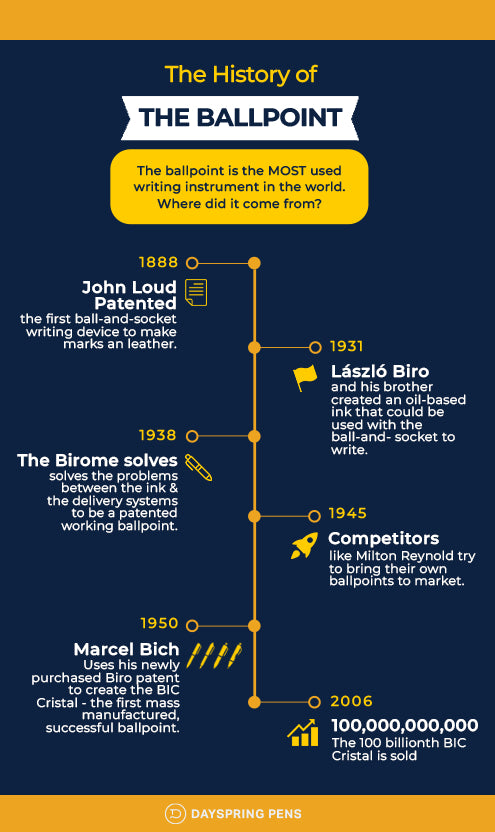
The history of ballpoint pens is a long and interesting one that starts long before the man known as the inventor of the ballpoint first filled his prototype with ink, but ultimately that man, László Biro, had an inspiration one day as he watched newspapers being printed.
You see, the trouble with the ballpoint pen wasn’t the ballpoint mechanism. That had been invented years prior by a man named John Loud. The problem was the ink used in the mechanism.
The ink dried out too quickly, clogging the pen, and smudged like crazy.
He noticed that newspaper ink dried fast and didn't smudge.
Working with his brother György, a chemist, he developed a thick, sticky, oil-based ink with a fast drying time. The brothers exhibited their pen at the Budapest International Fair in 1931 and filed for a patent seven years later on June 15, 1938.
The road to manufacturing the world's most popular pen was filled with twists and bumps, but ultimately Marcel Bich bought the ballpoint patent from László Biro and brought the first BIC Cristal pen to market in 1950.
Being the pioneer affordable ballpoint pen, and coupled with ink that neither leaked nor clogged, the BIC Cristal took off globally. It is now the most recognizable and most widely sold ballpoint pen in the world.
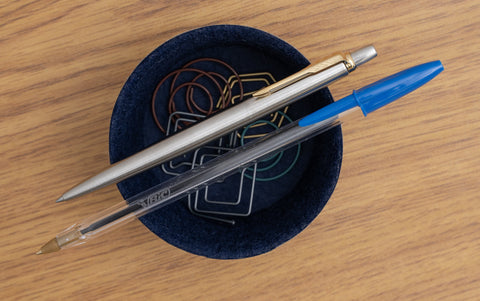
In 1954, Parker released the world’s first click ballpoint pen: the Jotter. It captured the world’s attention by the button activated mechanism inside a steel cap. This meant the pen came as one unit as opposed to other ballpoints with a detachable cap.
In addition, its nylon body design had an edge over its competitors that were made of plastic. Considered by customers as a design icon, the Jotter has sold over ¾ of a billion units since its launch.
Fun Fact: The Jotter took a team of 66 to design.
Manufacturing Process
The manufacture of ballpoint pens consists of a few basic steps with slight differences between brands. I am going to take you through them in summary.
Creating the Ink 💧
First, the ink is made by mixing raw materials in large batches. Heating and cooling at various points in the process helps the ingredients mix thoroughly.
Forming the Plastic Components 🔥
Polypropylene pellets or powder parts are melted and formed through extrusion or injection molding to make the plastic parts.
Making the Metal Components 🛡️
Apart from the rotating ball, other metal parts of a ballpoint pen include the spring, the tip holding the ball and in some cases, the pen body.
Small brass, aluminum, or stainless steel discs are heated until malleable and die cast molded to form different pieces of the pen.
Filling the Ink Reservoir 💉
When it comes to filling the cartridge, there are two methods.
Alternative 1
The tip and plastic reservoir are joined followed by injection of ink through the tip.
Alternative 2
After the plastic barrel is filled with ink, it’s joined to the metal tip. The barrel is placed in a centrifuge which spins it, moving ink to the tip.
Assembly of the Pen Parts 🛠️
After all the components are complete, it’s time to put them together. Assembly methods vary depending on whether the ballpoint pen is capped, click-action, or twist-action.
Ballpoint Pen Sizes
There are three broad categories of ballpoint pen sizes varying by the diameter of the tip:
- Fine
- Medium
- Broad
Fine ballpoint pens have tips that are 0.8 mm thick or less. They’re most suitable for small, precise writing, for example, signing checks or filling in tiny details in drawings.
If you’d like to see artists using these pens to take sketching to the next level, check out Goldspot’s article for some exceptional ballpoint pen art examples.
Pens whose tips measure between 0.9 and 1.2 mm thick are medium. Such ballpoint pens are flexible to suit different needs, making them popular for communal areas such as schools, receptions and waiting rooms.

Less common than the fine and medium types, ballpoint pens featuring tips 1.3 mm or thicker fall in the broad category. They work best for signatures or artwork where vast areas need to be shaded since they produce significantly thick lines.
Broad ballpoints are also great for calligraphy, allowing the artist to use less time to achieve their desired line weight while writing.
Types of Ballpoint Pens
Ballpoint pens fall into three major categories based on their functioning mechanism:
- Capped ballpoint pens
- Click-action/retractable ballpoint pens
- Twist action ballpoint pens
Among these categories, there are different types of ballpoint pens:
Low-viscosity ballpoint pens
If you’re looking for a merger between a regular ballpoint and a rollerball, you’ll find it in a low-viscosity ballpoint pen. These pens use inks with low viscosity, reducing the drag of the ball as it moves across the paper. One good example is the Pilot Acroball.
Pressurized ballpoint pens
While regular ballpoint pens face challenges when writing on non-horizontal surfaces or in extreme temperatures, pressurized pens contain mechanisms that overcome these problems.
The Tombow AirPress, for instance, pressurizes the ink refill every time you click the pen. This enables it to write upside down, on wet paper, and even under water.
Eco-friendly ballpoint pens
In response to the growing global plastic waste problem, some manufacturers have developed ballpoint pens made of recycled plastic, such as the Uni Power Tank.
Metal refillable ballpoints are another fantastic option for those who prefer reusable pens.
Popular Brands and Models of Ballpoint Pens
Let’s talk about which brands to know for ballpoints. For a real dive, check out my guide to the Best Ballpoint Brands.
Parker
Parker has made a name for themselves with their sophisticated pen designs. The fun, expressive aesthetic of their pens allow you to show off your unique taste.
What’s more, when you buy a Parker ballpoint pen, you’re assured that it will last due to the quality materials used.
Parker’s most popular ballpoint pen is, of course, the Jotter. Fondly referred to as the James Bond pen, the Jotter provides a pleasant writing experience thanks to its smooth gel Quink.
So popular is this pen that it has appeared in numerous movies and TV shows. If you’ve watched Shawshank Redemption, Apollo 13, or The Office while only focused on the plot, go back and see whether you can spot the Jotter making an appearance.
BIC
Most people have their first experience of writing with a ballpoint pen by using a BIC. They are affordable, reliable, and widely available in various retail outlets, making them an easy go-to choice for daily use.
The Cristal is BIC’s best known product, found in classrooms, offices, and lecture halls all over the world. This pen stands out for:
- Having long lasting ink
- Being comfortable in the hand
- Producing crisp lines
- Being durable
- Having a translucent barrel that allows you to keep track of the ink level

Chances are, if you’ve used ballpoint pens at some point in your life, the Cristal has been one of the pens.
The affordability of this pen makes it an excellent choice for students because they’re frequently taking notes. Given that you can get a pack of 24 for under $7, the convenience of the Cristal is hard to beat.
Such a budget friendly ballpoint pen is also ideal for people who tend to misplace theirs easily since replacing them costs next to nothing.
Waterman
The Waterman brand carries a long-standing legacy in pen manufacturing since 1883. Known for merging classic designs with modern innovation, their pens embody heritage and sophistication.
With every purchase of a Waterman pen, you get a taste of Parisian elegance, reflecting the city’s rich appreciation for the written word. The sleek aesthetic of these writing instruments truly mirrors the fine taste of their owners.
The Waterman Expert features an assertive silhouette bound to make an impression in professional settings. What’s more, its cigar shaped barrel gives you a comfortable feel in your hand. Finger fatigue when writing becomes a thing of the past when you switch to the Waterman Expert.
Beyond looks, this pen’s performance is exceptional. It provides a smooth, consistent, and long-lasting ink flow for an enjoyable writing experience.
Dayspring Pens
At Dayspring Pens, we’re all about helping people bring joy to their loved ones through personalized pens and after years of working with, selling, and engraving pens, we have started to use that knowledge to make pens like the Monroe.
Click-action, luxuriously finished, and filled with some of the best ink refills out there, the Monroe was not just made to look nice in a box or make a recipient say “oh that’s nice!” with the engraving. The Monroe was made to write.
This pen is also refillable, so you or your loved one will enjoy many years of use.
Simply choose the message you want engraved at the time of placing your order and leave the rest to us.
“My friend loves it. She was especially happy with the engraving. A great personalized gift. Very happy with the whole experience.” Helen C.
The following table compares different models of ballpoint pens from popular brands:
| Brand | Popular Models | Notable Features | Average Price |
| Parker | Jotter | Sleek lacquer body, refillable | $14-$26 |
| BIC | Cristal | Plastic body, disposable | $0.29-$0.7 |
| Waterman | Expert | Elegant lacquer body, refillable | $85-$172 |
| Dayspring Pens | Monroe | Lacquer finish with gold accents, refillable | $25.99-$35.99 |
Conclusion
Ballpoint pens are fascinating products of engineering, having evolved from rudimentary designs of the past to globally impact how people communicate. They are affordable and easily available, yet these same qualities make them overlooked by many people.
These writing tools might not be as elegant as their fountain pen counterparts, but are nonetheless important. Despite digital advancements, ballpoint pens remain relevant for the satisfaction they provide of putting pen to paper.
Beyond jotting down notes and to-do lists, these pens help us express our creativity and keep tangible records of ideas to implement later.
Interested in further exploring the world of ballpoint pens? Be sure to check out my other related articles:
- How to Get a Ballpoint Pen to Start Writing Again
- How Do You Remove Ballpoint Pen Ink
- What Are The Best Ballpoint Pen Brands
|
Sam Di Nardo is an author for Dayspring Pens, where she has honed her expertise in ballpoint, rollerball, gel and fountain pens since joining the team in 2018. From her initial role as an Engraver to becoming the Production Manager, Sam's journey has been marked by her passion for the history, manufacturing, and the unique value of gifted writing instruments. A graduate of Regent University with a degree in English Literature and a special interest in Old Norse literature, dive deeper into Sam's world and discover why she's your trusted guide in the realm of gift pens. |
